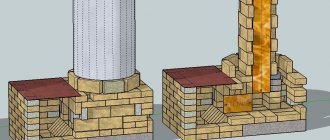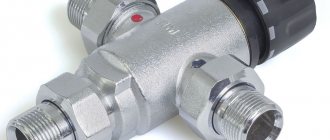Quite expensive and not all models of heating boilers are equipped with a GSM module. However, you can purchase it and connect it yourself, both to expensive and to the most budget models. The main thing is that the boiler must be able to connect external control, which, however, is the norm for almost all modern boiler units.
The cost of the device is on average 4-7 thousand rubles, which is quite a lot and comparable to good programmable thermostats, which are a more modern solution. However, GSM boiler control involves transmitting commands from anywhere in the country where there is cellular communication, while the thermostat’s coverage area is limited to the house itself or the range of home Wi-Fi. Therefore, the additional installation of a GSM module today is still more than justified.
Design and principle of operation of the GSM module for the boiler
In essence, the GSM module is a variation of a mobile phone, since it uses the same communication protocol.
The operating principle of the device is as follows:
- using a SIM card, the device connects to the GSM network;
- then it connects to the smartphone;
- You can send a signal to the device from the gadget;
- After receiving the signal, the module changes the boiler settings (raises or lowers the temperature, turns it on, off).
The module itself consists of the following structural elements:
- Thermostat . Controls the boiler temperature and sends a signal to the owner’s smartphone about its change. Many models allow you to use other notification methods (light, sound signals).
- Fasteners . Base for mounting the device. Typically designed for installation on a vertical wall.
- Power unit . The module elements are not designed to work with standard household voltage. Therefore they need a power supply. Typically the operating voltage of the device is 9 V or 12 V.
- Antenna . Allows you to receive signals in the GSM range, with the help of which the module is controlled.
- Sensor _ Determines the temperature of the boiler and transmits the received information to the thermostat for further processing and notification to the owner. Most sensors are capable of operating at temperatures from -50 o C to +99 o C. This allows them to be used in almost any conditions.
- Backup power supply . Represents a battery or accumulator. Designed in case of a power outage or power supply failure. Ensures long-term battery life of the device while maintaining full functionality.
Expert opinion
Grebnev Vadim Savelievich
Heating system installer
Another essential element of the GSM module for boiler control is the SIM card. After all, it is with the help of it that the device connects to the mobile network. But it will have to be purchased separately. Some manufacturers include a SIM card with a suitable tariff in the kit, but this is rare.
Operating modes
Most existing device models have two operating modes:
- Automatic . The owner of the device sets the necessary settings, and the device operates in accordance with them. For example, you can set the boiler to turn off when a certain temperature is reached and turn on again after cooling.
- Manual . In this case, control is carried out completely manually. A smartphone is used for this.
- Anxious . Essentially, this is the same automatic mode. But with one caveat - the system notifies the user in case of emergency situations (for example, an unexpected increase in temperature above permissible values or spontaneous shutdown of the boiler).
Some models allow you to combine modes. For example, you can enable manual control of the boiler and at the same time enable notifications about emergency situations.
What boilers does it work with?
Before purchasing a module, you need to find out whether the heating boiler supports the connection of such a device. Not all models have such support.
Autonomous systems with forced circulation of coolant (that is, equipped with a pump) are suitable for connecting the device. In this case, it is necessary to rework the safety system in order to prevent breakthroughs at the points where the module is connected.
Expert opinion
Grebnev Vadim Savelievich
Heating system installer
If the module has an air temperature sensor, then it can be used with other types of boilers. However, due to measuring t outside the system, it will work a little less accurately.
Features of operation in various types of boilers
The device has specific operation in different types of heating systems:
- When used in electric boilers, voltage monitoring is possible. The device can also signal a short circuit.
- When used with several boilers at the same time, the device can summarize information from them. This is relevant when used in production or in utility rooms.
- In pellet boilers using wood pellets, the module can regulate the fuel supply to the system.
Heated floor control
In each case, the choice of controller for a system for remote control of a heated floor via the Internet depends on the installation option used:
- circulation pump control;
- using a thermal head;
- servo control;
- three-way valve control;
- installation of a weather-compensating controller;
- group adjustment.
I will not dwell on this in detail, since the topic of preparing a heated floor deserves a separate article.
Warm floors can be used not only at home, but also in the bathhouse...
In this case, the operating principle is quite simple. Heat regulators receive information from temperature sensors and execute the program specified by the user. Depending on the system used, zone control is also possible.
To set up remote control of water heated floors, equipment from the Polish company TECH Controllers is required. In general, any heat regulators are suitable. You can buy models whose characteristics include information about the presence of a built-in GSM modem.
When is a module needed?
A GSM module for controlling the boiler is required when the owner of the house is away for a long time, provided that it is necessary to maintain a certain temperature or turn on the heating in a timely manner.
The most common situations where this is necessary include the following:
- Long departure . The owner of the house goes on a business trip or vacation. In this case, you cannot completely turn off the heating - the system will freeze. At the same time, there is no one to operate the boiler at home.
- Cottage with heating system . If a heating system is installed in a country house, then when the boiler is turned off during the cold season, it will freeze. To prevent this, you can drain the system. But then it will be impossible to come to the dacha in winter because of the cold in the house. The solution to the problem is to remotely maintain a low positive temperature to prevent freezing using a GSM module.
Remote automatic heating of a standard dacha as an integral part of the overall scheme
A professional approach to real estate heating allows the equipment involved to function stably in various modes. With the right approach, you can combine several systems at once to achieve a good result. This remote correction option does not have a central controller. But at the same time, a fairly large percentage of the unused capabilities of the units can be used in other “smart home” schemes. Even a classic GSM module is capable of not only receiving incoming calls, but also sending reports about the situation in the house to a smartphone. Thanks to this, you can quickly find out about a flood or a starting fire.
How to choose a GSM module
When choosing a GSM module, you should pay attention to the following parameters:
- Ease of management . With a smartphone, everything is clear - the device is controlled using an application. But if the owner of the house, interaction with the device occurs in a different way. There are two most common control methods: physical buttons and touch screen. Models with the second option are more convenient (they show more information about the operation of the heating system). But they cost more. Of course, there are also models that are controlled exclusively from a smartphone. But you shouldn’t buy them - using such devices is not very convenient.
- Equipment . The basic delivery set of the module includes an antenna, an internal temperature sensor, fasteners and the device itself. But there are models with extended equipment. It may include external temperature sensors, gas detectors and other components. The kit is selected based on specific tasks. For example, if the goal is to ensure maximum safety, it is better to choose an option with a gas sensor. And if you just need to control the boiler remotely, the minimum configuration will do.
- Number of channels . The more there are, the more users can control the device. The cheapest models have two channels. But if there are three or four household members, this option is completely unsuitable. Therefore, the more people in the family, the more channels there should be on the module. It should be borne in mind that multi-channel devices will cost more.
- Backup battery capacity . The larger it is, the longer the device can work offline. You need to keep in mind that you should not overpay for a high-capacity battery where it is not needed. It is relevant only in the case when in the locality where the house is located, electricity is often cut off for a long time.
A GSM module for a boiler is a case where the quality of the device directly depends on the price. The higher the cost, the more powerful the processor (which means more settings can be set), the more convenient the control and the richer the equipment. Therefore, saving is always a compromise in relation to the comfort of using the device.
Sending commands from a smartphone
This option is more convenient to use, but you need to spend more money on it. In order to send a remote command that will notify the equipped system that it is time to prepare for the arrival of property owners and turn on the heating, you need to buy a GSM module. This device is a regular switch that is responsible for connecting when calling from a phone. You can enter several numbers into the unit’s memory at once, calls from which will be perceived as commands. The product must be installed in a common switchboard and high-quality electric radiators are connected through it. To have a warm room waiting for you upon arrival at your dacha, you just need to call from your smartphone or send an SMS. If you had to be delayed or the train was suddenly cancelled, then just make another call to turn off the heating.
Important! The device fits perfectly with a SIM card from any mobile operator. It is best to opt for the option that provides the highest quality communication in a certain region.
Self-installation of purchased socket
How to connect the module yourself
The algorithm for connecting the module to the boiler is always approximately the same. The model of the device does not matter at all.
To connect the device, you must:
- de-energize the boiler;
- remove the casing;
- connect or solder the module wires to the boiler board in accordance with the instructions;
- install a SIM card, antenna, sensors;
- put back the boiler casing;
- turn on the module and synchronize it with your smartphone;
- restore power supply.
Ideal for a classic cottage
In remote regions of Russia, the market offers a relatively small range of heating units. Most often, dachas are heated with compact stoves burning coal or wood; in the best case, the owners of such real estate can install a solid fuel boiler or electric radiators. But even with implemented systems running on diesel fuel and natural gas, universal automatic switching is not always provided. The only viable option in this case is to use electricity. But since the use of such heating units is quite expensive, it is better to use this method as an auxiliary one.
The remote control method allows one or several rooms to be heated to the specified level before the owner arrives, while ensuring the stable functioning of the sewerage and water supply systems. After which you can start the main heating system in a comfortable environment, but only in manual mode.
The evolution of modern technology
The best models of GSM modules for remote control of heating boilers
Let's look at several current device models available for purchase today.
KotelOK 2.0
A simple, inexpensive and reliable model made in Russia. The cost of the product varies from 5,000 to 6,500 rubles.
Consists of the following components:
- GSM unit with antenna;
- control Panel;
- sensor.
The control panel has a wide monochrome display and four setting buttons. A good GSM antenna provides good signal quality.
The main disadvantage of the device:
- control using SMS commands (no application). This is not very convenient.
The main advantage of KotelOK 2.0:
- possibility of fine adjustment of the temperature of the heating system. It can be changed down to 0.1 o C.
Telemetrics 3
Compact and convenient GSM module. It has a large and most informative monochrome liquid crystal display. Control is carried out using three physical buttons located under the screen.
- The main advantage of the device
Versatility. It can be connected not only to the boiler, but also to any other device (for example, an air conditioner).
- Minus
Lack of complete outdoor antenna. Of course, third-party installation is possible. But these are additional costs. Which are completely inappropriate given the high price of the device (about 9,000 - 10,000 rubles).
Optima-1 Heat monitor
A simple, reliable and easy-to-use device. It consists of a pair of thermostat - GSM module. Able to work with several boilers simultaneously. It is also possible to connect to an alarm system.
Programming is provided for the next seven days for use in automatic mode. There is frost protection, which allows the model to be used in subzero temperatures.
Thanks to the presence of an external antenna in the kit, stable signal reception from the owner’s smartphone is ensured with almost complete absence of interruptions.
- The main disadvantage of the device
Insufficiently informative interface. There is no display here. Instead, indicator LEDs are used. It is clear that it is difficult to reflect all the necessary information with their help.
The cost of the device is from 8,500 to 9,000 rubles.
Remote systems NOBO Energy Control
It is quite easy to use such developments of specialists. Control is carried out through a single center - Orion 700 devices. Auxiliary elements allow you to remotely control absolutely all electrical appliances and convectors. The user can remotely control energy consumption. Experts made sure that the temperature was maintained exactly to 1 °C. Radiators are turned on and off according to a given program, and the universal built-in timer can be programmed not only for a day, but also for a whole week. Thanks to this, the final electricity consumption is reduced by 30%, but without compromising the comfort of living.











